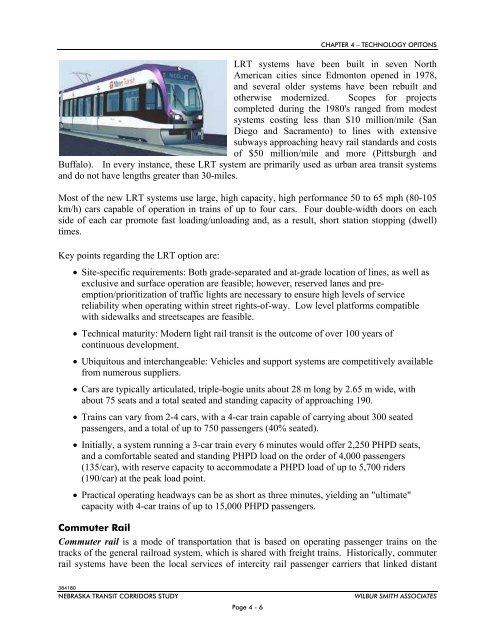NTRAC Final Study - Nebraska Department of Roads - State of ...
NTRAC Final Study - Nebraska Department of Roads - State of ...
NTRAC Final Study - Nebraska Department of Roads - State of ...
Create successful ePaper yourself
Turn your PDF publications into a flip-book with our unique Google optimized e-Paper software.
CHAPTER 4 – TECHNOLOGY OPITONS<br />
LRT systems have been built in seven North<br />
American cities since Edmonton opened in 1978,<br />
and several older systems have been rebuilt and<br />
otherwise modernized. Scopes for projects<br />
completed during the 1980's ranged from modest<br />
systems costing less than $10 million/mile (San<br />
Diego and Sacramento) to lines with extensive<br />
subways approaching heavy rail standards and costs<br />
<strong>of</strong> $50 million/mile and more (Pittsburgh and<br />
Buffalo). In every instance, these LRT system are primarily used as urban area transit systems<br />
and do not have lengths greater than 30-miles.<br />
Most <strong>of</strong> the new LRT systems use large, high capacity, high performance 50 to 65 mph (80-105<br />
km/h) cars capable <strong>of</strong> operation in trains <strong>of</strong> up to four cars. Four double-width doors on each<br />
side <strong>of</strong> each car promote fast loading/unloading and, as a result, short station stopping (dwell)<br />
times.<br />
Key points regarding the LRT option are:<br />
Site-specific requirements: Both grade-separated and at-grade location <strong>of</strong> lines, as well as<br />
exclusive and surface operation are feasible; however, reserved lanes and preemption/prioritization<br />
<strong>of</strong> traffic lights are necessary to ensure high levels <strong>of</strong> service<br />
reliability when operating within street rights-<strong>of</strong>-way. Low level platforms compatible<br />
with sidewalks and streetscapes are feasible.<br />
Technical maturity: Modern light rail transit is the outcome <strong>of</strong> over 100 years <strong>of</strong><br />
continuous development.<br />
Ubiquitous and interchangeable: Vehicles and support systems are competitively available<br />
from numerous suppliers.<br />
Cars are typically articulated, triple-bogie units about 28 m long by 2.65 m wide, with<br />
about 75 seats and a total seated and standing capacity <strong>of</strong> approaching 190.<br />
Trains can vary from 2-4 cars, with a 4-car train capable <strong>of</strong> carrying about 300 seated<br />
passengers, and a total <strong>of</strong> up to 750 passengers (40% seated).<br />
Initially, a system running a 3-car train every 6 minutes would <strong>of</strong>fer 2,250 PHPD seats,<br />
and a comfortable seated and standing PHPD load on the order <strong>of</strong> 4,000 passengers<br />
(135/car), with reserve capacity to accommodate a PHPD load <strong>of</strong> up to 5,700 riders<br />
(190/car) at the peak load point.<br />
Practical operating headways can be as short as three minutes, yielding an "ultimate"<br />
capacity with 4-car trains <strong>of</strong> up to 15,000 PHPD passengers.<br />
Commuter Rail<br />
Commuter rail is a mode <strong>of</strong> transportation that is based on operating passenger trains on the<br />
tracks <strong>of</strong> the general railroad system, which is shared with freight trains. Historically, commuter<br />
rail systems have been the local services <strong>of</strong> intercity rail passenger carriers that linked distant<br />
384180<br />
NEBRASKA TRANSIT CORRIDORS STUDY<br />
Page 4 - 6<br />
WILBUR SMITH ASSOCIATES

















